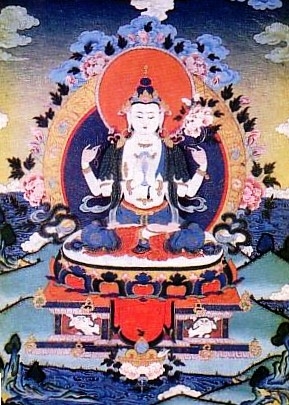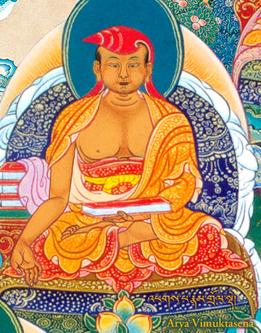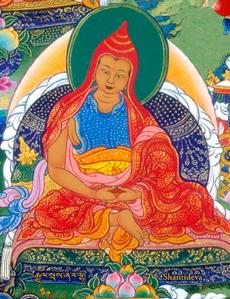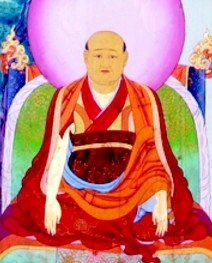Bodhichitta

Bodhichitta (Skt. bodhicitta; Tib. བྱང་ཆུབ་ཀྱི་སེམས་, chang chub kyi sem; Wyl. byang chub kyi sems) is the compassionate wish to attain enlightenment for the benefit of all beings.
Nature
| This section contains Tibetan script. Without proper Tibetan rendering support configured, you may see other symbols instead of Tibetan script. |
Buddhist scholars have debated whether bodhichitta is to be categorized as the 'main mind' (Tib. གཙོ་སེམས་, tso sem; Wyl. gtso sems) or a 'mental state' (Tib. སེམས་བྱུང་, sem jung; Wyl. sems byung). Asanga and Vasubandhu were among those claiming it is a mental state, while Arya Vimuktasena and Haribhadra believe that it is the main mind. In his Light on the 25,000 Verses (Tib. ཉི་ཁྲིད་སྣང་བ་, nyi khrid snang ba), Arya Vimuktasena specifies that it is the mental consciousness (Tib. ཡིད་ཀྱི་རྣམ་ཤེས་, yid kyi rnam shes).
Definition

Literal Meaning/Etymology
Bodhi means our ‘enlightened essence’ and chitta (Skt. citta) means ‘heart’ or 'mind', hence the translation ‘the heart of enlightened mind’.
Scholarly Definitions
The most famous definition of bodhichitta appears in Maitreya's Abhisamayalankara:
- Arousing bodhichitta is: for the sake of others,
- Longing to attain complete enlightenment.[1]
This has twin aspects or purposes: 1) focusing on sentient beings with compassion, and 2) focusing on complete enlightenment with wisdom.
Khenpo Pema Vajra defines bodhichitta as "the wish to attain enlightenment in order to free all other sentient beings from the sufferings of existence and lead them to the unsurpassable bliss of omniscience."[2]
Khenpo Tsöndrü defines the generation of bodhichitta as "a special type of mental consciousness endowed with two aspects, inspired by the cause, longing to bring about the welfare of others, and accompanied by the support, longing to attain complete and perfect awakening."[3]
Divisions

Absolute & Relative
Bodhichitta is categorized into ‘relative’ or ‘conventional bodhichitta’, and ‘absolute bodhichitta’.
- Relative bodhichitta entails the compassionate wish to attain enlightenment for the benefit of all living beings and to train in the methods to achieve that aim.
- Absolute bodhichitta is the direct insight into the absolute nature of things.
Aspiration & Action
Within relative bodhichitta there is also the distinction between ‘bodhichitta in aspiration’ and ‘bodhichitta in action’, which is portrayed by Shantideva as the difference between deciding to go somewhere and actually making the journey:
|
|
The Three Types of Commitment
- the king's way of arousing bodhichitta, with the great wish
- the boatman's way of arousing bodhichitta, with sacred wisdom
- the shepherd's way of arousing bodhichitta, beyond compare
Four Types of Bodhichitta According to the Paths and Levels
Bodhichitta can also be divided according to the five paths and ten bhumis:
- bodhichitta of aspiring conduct (Tib. མོས་པས་སྤྱོད་པའི་སེམས་བསྐྱེད་, Wyl. mos pas spyod pa'i sems bskyed ) (path of accumulation onwards)
- bodhichitta of pure noble intention (Tib. ལྷག་བསམ་རྣམ་དག་གི་སེམས་བསྐྱེད་, Wyl. lhag bsam rnam dag gi sems bskyed) (first bhumi onwards)
- bodhichitta of full maturation (Tib. རྣམ་པར་སྨིན་པའི་སེམས་བསྐྱེད་, Wyl. rnam par smin pa'i sems bskyed ) (eighth bhumi onwards)
- bodhichitta free from all obscurations (Tib. སྒྲིབ་པ་སྤངས་པའི་སེམས་བསྐྱེད་, Wyl. sgrib pa spangs pa'i sems bskyed ) (at the level of buddhahood)
There is also a division into twenty-two similes of bodhichitta, and the Sagaramatiparipriccha Sutra (Tib. བློ་གྲོས་རྒྱ་མཚོས་ཞུས་པའི་མདོ་, Wyl. blo gros rgya mtshos zhus pa'i mdo) mentions a classification according to eighty inexhaustibles which are discussed in Mipham Rinpoche's Khenjuk.
The Actual Training in Bodhichitta

Patrul Rinpoche saysCite error: Closing </ref> missing for <ref> tag, Longchenpa explains the literal meaning of bodhichitta in Dzogchen:
|
|
This is his commentary[5] on the verse:
|
|
Notes
- ↑ Abhisamayalankara I, 18, ༈ སེམས་བསྐྱེད་པ་ནི་གཞན་དོན་ཕྱིར། །ཡང་དག་རྫོགས་པའི་བྱང་ཆུབ་འདོད། །, sems bskyed pa ni gzhan don phyir// yang dag rdzogs pa'i byang chub 'dod//
- ↑ ༈ གཞན་སེམས་ཅན་ཐམས་ཅད་སྲིད་པའི་སྡུག་བསྔལ་ལས་བསྒྲལ་ཏེ་ཐམས་ཅད་མཁྱེན་པའི་བདེ་བ་བླ་ན་མེད་པ་ལ་འཇོག་པའི་དོན་གྱི་ཆེད་དུ་བྱང་ཆུབ་ཐོབ་པར་འདོད་པ།, gzhan sems can thams cad srid pa'i sdug bsngal las bsgral te thams cad mkhyen pa'i bde ba bla na med pa la 'jog pa'i don gyi ched du byang chub thob par 'dod pa from Notes on Bodhichitta to Illuminate the Path of the Victorious One's Heirs.
- ↑
 The Words of Jikmé Chökyi Wangpo: A Commentary Presenting the Subject Matter of the Great Treatise, the Abhisamayalankara
The Words of Jikmé Chökyi Wangpo: A Commentary Presenting the Subject Matter of the Great Treatise, the Abhisamayalankara
- ↑ Bodhicharyavatara, I, 15 & 16
- ↑ Longchen Rabjam: A Treasure Trove of Scriptural Transmission (Skt. Dharmadhātu ratna koṣa nāma vṛtti; Tib. ཆོས་དབྱིངས་རིན་པོ་ཆེའི་མཛོད་ཅེས་བྱ་བའི་འགྲེལ་པ།, Wyl. chos dbyings rin po che'i mdzod ces bya ba'i 'grel pa), see the entry for Treasury of Dharmadhatu.
Further Reading
- Khunu Rinpoche, Vast as the Heavens, Deep as the Sea: Verses in Praise of Bodhicitta, Wisdom Pub., 1999.
- The Light of Wisdom, Volume 1. Root text by Padmasambhava and commentary by Jamgön Kongtrül the Great. Published by Shambhala Publications ISBN 0-87773-566-2, Chapters 12, 13 & 14, pages 115-155.
